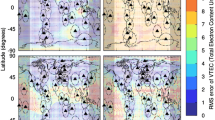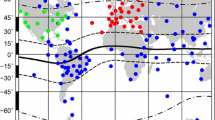Abstract
GNSS observables for ionospheric estimation are commonly based on carrier-to-code leveling (CCL) and precise point positioning (PPP) methods. The CCL method is a geometry-free method which uses carrier phase to level pseudorange observation for decreasing multipath error and observation noise. However, the ionospheric observable based on the CCL has been proven to be affected by leveling errors. The leveling errors are caused by pseudorange multipath and intraday variation of receiver DCB. To obtain more accurate ionospheric observable, the PPP method takes advantage of precise satellite-to-ground range for retrieving slant total electron content and is less affected by the leveling errors. Previous studies have only proven that the ionospheric observables extracted by the two methods are affected by the leveling errors. The influence on ionospheric observable by the pseudorange inter-receiver satellite bias (IRSB) of the receiver has not been taken into consideration. Also, the magnitude of the differences between the ionospheric observables extracted by the two methods has also not been given. In this work, three methods, namely, the CCL, the conventional ionospheric-free PPP method which uses the ionospheric-free Hatch–Melbourne–Wubbena (HMW) function, and the University of Calgary (UOFC) PPP method, are selected to analyze and compare the differences of ionospheric observables and the global ionospheric maps, using a large number of measured data from international GNSS service global stations. Experimental results show that the accuracy of ionospheric observables obtained by the three methods is not only related to the leveling error, but also pseudorange IRSB. The IRSB of the receiver exerts a major effect on the ionospheric observables obtained by the CCL method and a minor effect on the ionospheric observables obtained by the HMW and UOFC methods. The accuracies in the latter case are similar and superior to those obtained by the CCL. The differences of the ionospheric observables obtained by the CCL and UOFC methods, or the CCL and HMW methods, are at decimeter level, whereas the difference of the ionospheric observables obtained by the UOFC and HMW methods is at centimeter level. The UOFC method presented the highest single-frequency pseudorange positioning accuracy using estimated global ionospheric products, followed by the HMW and the CCL methods which presented the lowest positioning accuracy.











Similar content being viewed by others
References
Banville S, Langley RB (2011) Defining the basis of an “integer-levelling” procedure for estimating slant total electron content. In: Proc. ION GNSS 2011, Portland, OR, September 2011, pp 2542–2551
Banville S, Zhang W, Ghoddousi-Fard R, Langley RB (2012) Ionospheric monitoring using “integer-levelled” observations. In: Proc. ION GNSS 2012, Nashville, TN, September 2012, pp 2692–2701
Blewitt G (1989) Carrier phase ambiguity resolution for the global positioning system applied to geodetic baselines up to 2000 km. J Geophys Res Solid Earth 94(B8):10187–10203. https://doi.org/10.1029/JB094iB08p10187
Ciraolo L, Azpilicueta F, Brunini C, Meza A, Radicella SM (2007) Calibration errors on experimental slant total electron content (TEC) determined with GPS. J Geod 81(2):111–120. https://doi.org/10.1007/s00190-006-0093-1
Gao Y, Shen X (2002) A new method for carrier-phase-based precise point positioning. Navigation 49(2):109–116. https://doi.org/10.1002/j.2161-4296.2002.tb00260.x
Hatch R (1982) The synergism of GPS code and carrier measurements. In: Proceedings of the 3rd international geodetic symposium on satellite Doppler positioning, vol 2. Las Cruces–New Mexico, 1982, pp 1213–1231
Hauschild A, Montenbruck O (2016a) A study on the dependency of GNSS pseudorange biases on correlator spacing. GPS Solut 20(2):159–171. https://doi.org/10.1007/s10291-014-0426-0
Hauschild A, Montenbruck O (2016b) The effect of correlator and front-end design on GNSS pseudorange biases for geodetic receivers. Navigation 63(4):443–453. https://doi.org/10.1002/navi.165
Hernández-Pajares M, Juan JM, Sanz J, Orus R, Garcia-Rigo A, Feltens J, Komjathy A, Schaer SC, Krankowski A (2009) The IGS VTEC maps: a reliable source of ionospheric information since 1998. J Geod 83(3):263–275. https://doi.org/10.1007/s00190-008-0266-1
Hernández-Pajares M, Juan JM, Sanz J, Aragón-Àngel À, García-Rigo A, Salazar D, Escudero M (2011) The ionosphere: effects, GPS modeling and the benefits for space geodetic techniques. J Geod 85(12):887–907. https://doi.org/10.1007/s00190-011-0508-5
Kouba J, Héroux P (2001) Precise point positioning using IGS orbit and clock products. GPS Solut 5(2):12–28. https://doi.org/10.1007/PL00012883
Lachapelle G, Hagglund J, Falkenberg W, Bellemare P, Casey M, Eaton M (1986) GPS land kinematic positioning experiments. In: Proceeding fourth international geodetic symposium on satellite positioning, Austin, Texas, April 28–May 2, vol 2, pp 1327–1344
Liu L, Wan W, Ning B, Zhang ML (2009) Climatology of the mean total electron content derived from GPS global ionospheric maps. J Geophys Res Sp Phys. https://doi.org/10.1029/2009JA014244
Mannucci AJ, Wilson BD, Yuan DN, Ho CH, Lindqwister UJ, Runge TF (1998) A global mapping technique for GPS-derived ionospheric total electron content measurements. Radio Sci 33(3):565–582. https://doi.org/10.1029/97RS02707
Melbourne WG (1985) The case for ranging in GPS-based geodetic systems. In: Proceedings of first international symposium on precise positioning with the global positioning system, Rockville, 15–19 April, MD, USA, pp 373–386
Schaer S (1999) Mapping and predicting the Earth’s ionosphere using the global positioning system. PhD thesis, University of Berne, Switzerland
Shi C, Fan L, Li M, Liu ZZ, Gu SF, Zhong SM, Song WW (2016) An enhanced algorithm to estimate BDS satellite’s differential code biases. J Geod 90(2):161–177
Wübbena G (1985) Software developments for geodetic positioning with GPS using TI-4100 code and carrier measurements. In: Proceedings of 1st international symposium on precise point positioning with the global positioning system, April 15–19, Rockville, pp 403–412
Xiang Y, Gao Y (2017b) Improving DCB estimation using uncombined PPP. Navigation 64(4):463–473. https://doi.org/10.1002/navi.207
Xiang Y, Gao Y, Shi J, Xu C (2017a) Carrier phase-based ionospheric observables using PPP models. Geod Geodyn 8(1):17–23. https://doi.org/10.1016/j.geog.2017.01.006
Zhang BC, Ou JK, Yuan YB, Li ZS (2012) Extraction of line-of-sight ionospheric observables from GPS data using precise point positioning. Sci China Earth Sci 55(11):1919–1928. https://doi.org/10.1007/s11430-012-4454-8
Zhang R, Song WW, Yao YB, Shi C, Lou YD, Yi WT (2015) Modeling regional ionospheric delay with ground-based BeiDou and GPS observations in China. GPS Solut 19(4):649–658. https://doi.org/10.1007/s10291-014-0419-z
Zumberge JF, Heflin MB, Jefferson DC, Watkins MM, Webb FH (1997) Precise point positioning for the efficient and robust analysis of GPS data from large networks. J Geophys Res Solid Earth 102(B3):5005–5017. https://doi.org/10.1029/96JB03860
Acknowledgements
Observation data and precise products downloaded from CDDIS and CODE are acknowledged. The authors also thank the valuable comments and suggestions from the anonymous reviewers. This study was supported by the State Key Research and Development Program (2017YFB0503401), the National Natural Science Funds (Grant no. 41704026, Grant no. 41374034, Grant no. 41404010), and also the Open Research Fund of State Key Laboratory of Information Engineering in Surveying, Mapping and Remote Sensing (Grant no. 15P01). We thank all the anonymous reviewers for their constructive and valuable comments.
Author information
Authors and Affiliations
Corresponding author
Rights and permissions
About this article
Cite this article
Chen, L., Yi, W., Song, W. et al. Evaluation of three ionospheric delay computation methods for ground-based GNSS receivers. GPS Solut 22, 125 (2018). https://doi.org/10.1007/s10291-018-0788-9
Received:
Accepted:
Published:
DOI: https://doi.org/10.1007/s10291-018-0788-9




